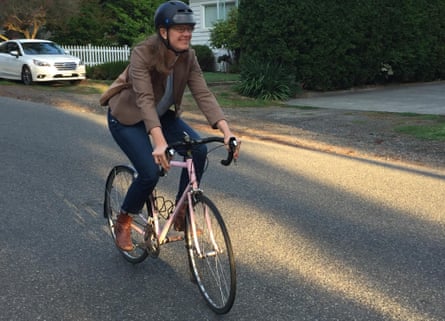Every day, Elizabeth Kiker cycles to her work through the streets of Seattle. As the executive director of a big bicycle club, she wants to show people that you don’t need fancy gear to ride a bike – so she rides in her skirt and office shoes. But she does wear a helmet. If she didn’t, she would risk a $102 (£67) fine.
Seattle is one of the few big cities in the world where cyclists of all ages are legally required to wear a helmet. “There’s an interesting conversation going on about this, because it could dissuade people from cycling,” says Kiker. “And yet, it is safer if you fall. I once slipped with my bike and fell on my helmet and I was glad I was wearing it.”
Five thousand miles to the east, Marco te Brömmelstroet cycles to his job as director of the Urban Cycling Institute of the University of Amsterdam. The wind is blowing freely through his hair. “Cycling without a helmet is something I take for granted, I never give it any thought,” he says. “But it does amplify the feeling of ultimate freedom.”
In Amsterdam, adults don’t wear helmets while riding city bikes – they don’t even consider it an option. Helmets are mainly worn by tourists and expats, whom the Dutch regard with bemusement, even ridicule. They know their country is a very safe place to ride a bike: in the Netherlands, the number of cyclists killed per travelled mile is the lowest in the world.

Should cyclists in cities wear helmets? And should there be such a thing as a helmet law? Only last week, Britain’s transport minister Robert Goodwill was criticised because he urged cyclists to wear helmets – while admitting he rides bareheaded through London himself. The helmet question has stirred up a heated debate for a long time and it’s not likely to end very soon. Both critics and advocates seem to have a point.
“Helmets are very effective in preventing head injuries and there are many studies to prove it,” maintains Randy Swart of the American Bicycle Helmet Safety Institute. “These are medical studies, some of them based on emergency room data, some of them based on crash data from accident scenes. Just as important is the information that comes from bicycle clubs and organisations. From their experience, they confirm what the medical studies show: that helmets are effective. There’s a lot of argument about the precentage of injuries that can be prevented by wearing a helmet, but I estimate it to be somewhere around two thirds.”
Te Brömmelstroet does not agree. “The problem is precisely that there are not so many studies and that most of the existing studies are methodologically not very sound,” he says. According to him, there only are a limited amount of scenarios in which helmets provide protection. “That is when the cyclist falls without being involved in a crash. But when you collide with a car that drives faster than 20 miles an hour, a helmet does nothing to save you.”
In the US, where rules on helmets vary from state to state, Seattle made them mandatory 12 years ago. The helmet law came about mainly due to pressure from people who worked in local health care. “It didn’t come about because Seattle would be more dangerous for cyclists than other cities,” Kiker says. “There has been some debate lately, because it was feared the helmet law would hurt our new bike share programme, but it hasn’t. They have been very innovative about how to incorporate the helmet law into the programme. You can now check out a helmet when you check out a bike.”
The answer to the helmet question is not as simple as it seems, says Te Brömmelstroet. “It is important to realise that wearing a helmet can have negative effects. It does not always make cycling safer. Cyclists with helmets are liable to take more risks because they consider themselves safe. And an English study has shown that motorists give considerably less space whilst overtaking cyclists with helmets than when they overtake cyclists that go bareheaded. If you look at it this way, wearing a helmet could lead to more injuries than not wearing one.’’

That wearing a helmet can lead to more aggression from motorists, at least in the Netherlands, is something Te Brömmelstroet knows from experience. “I cycle to work on a city bike without a helmet, but at the weekends, I wear one while riding my racing bicycle. In the last case, I encounter more aggression. I suddenly seem to belong to a group that triggers a lot of anger.’’
Although they disagree on the safety that helmets provide, Swart, Kiker and Te Brömmelstroet all agree on one thing: it’s not helmets that make cycling truly safe, but the amount of cyclists on the road. “In all American cities where bike riding has gone up, crashes have come down,” says Kiker.
The big question here, of course, is: do cycle helmets increase or decrease the number of cyclists in a city? “If you want to encourage cycling, helmet laws are certainly not a good idea,” says Te Brömmelstroet. “When you make helmets mandatory, people will think that cycling is impractical and even dangerous. For example, in Australia the number of cyclists went down drastically after helmets became mandatory.”
“If a helmet law were going to reduce cycling significantly, I would say you’d have to think very seriously before passing it. It is a valid consideration,” Swart agrees. “But Australia is half a world away. Compulsory helmets might start a revolution in one place but can be just fine in another. A lot of what we are talking about is simply cultural. In the US, we do not have any documented situations where passing a helmet law reduced cycling.”

“In Seattle, the amount of cyclists has definitely gone up,” says Kiker. “Of course, there are fewer bikes on the road than in Dutch cities. But I do feel safe while riding through the city. And I ride everywhere. My bike is how I get around.”
When the numbers of cyclist go up, there is a clear impact on how drivers treats cyclists. Swart explains: “In most cities in the United States, drivers are not expecting bicycles. So they aren’t looking in the right direction when they overtake one. In some places, drivers don’t even know how to react to a cyclist. When more people cycle in a city, drivers become accustomed to them, they accept them and they learn how to safely deal with them. More cyclists means greater safety, so we should do all we can to encourage cycling.
“In cities where there is a lot of cycling, the majority of the motorists also often ride a bicycle. So they are much more aware of the impact of their driving style on cyclists,” says Te Brömmelstroet. “Car speeds come down in cities where cycling is important, and this opens opportunities to mix traffic in such a way that motorists behave as guests. In the Netherlands, you can see this in so-called fietsstraten, or bicycle-streets, where cyclists are the dominant mode of transport.”
The problem is not only that helmet laws would reduce cycling, he says. “When governments make helmets compulsory, they leave the responsibility for safety in the hands of the cyclists. They are blaming the victim. Whereas in the Netherlands, we believe in the responsibility of the motorist. That’s why our government has introduced strict liability.”
This means that in Amsterdam, in case of a crash, the motorist is liable for financial damage, unless he can prove that the cyclist was at fault – but then he still will be liable for half of the damage.
Swart is not totally convinced whether this is a good measure: “There are two considerations here. One is: it will make the motorist more careful. And that is very good. But secondly, I can also imagine that the motorist will consider it unfair when the cyclist didn’t wear a helmet and is then subject to an injury that would not have happened if he were wearing one.”
“As a scientist and as a father, I am not against helmets,” says Te Brömmelstroet. “But I am certainly against helmet laws. If you want to make cycling safer, start with good infrastructure: build segregated cyclepaths. I am against the false idea of security that helmets offer. They may have some protective value, but not as much as people tend to think. And why all this focus on protecting the head?’’ he adds jokingly. “If you want to be really safe, you should also consider elbow, knee and back protection. And why all this emphasis on the need to wear helmets on bikes? The majority of head injuries occur in cars, but motorist wouldn’t dream of wearing a helmet!”
Follow Guardian Cities on Twitter and Facebook to join the discussion

Comments (…)
Sign in or create your Guardian account to join the discussion